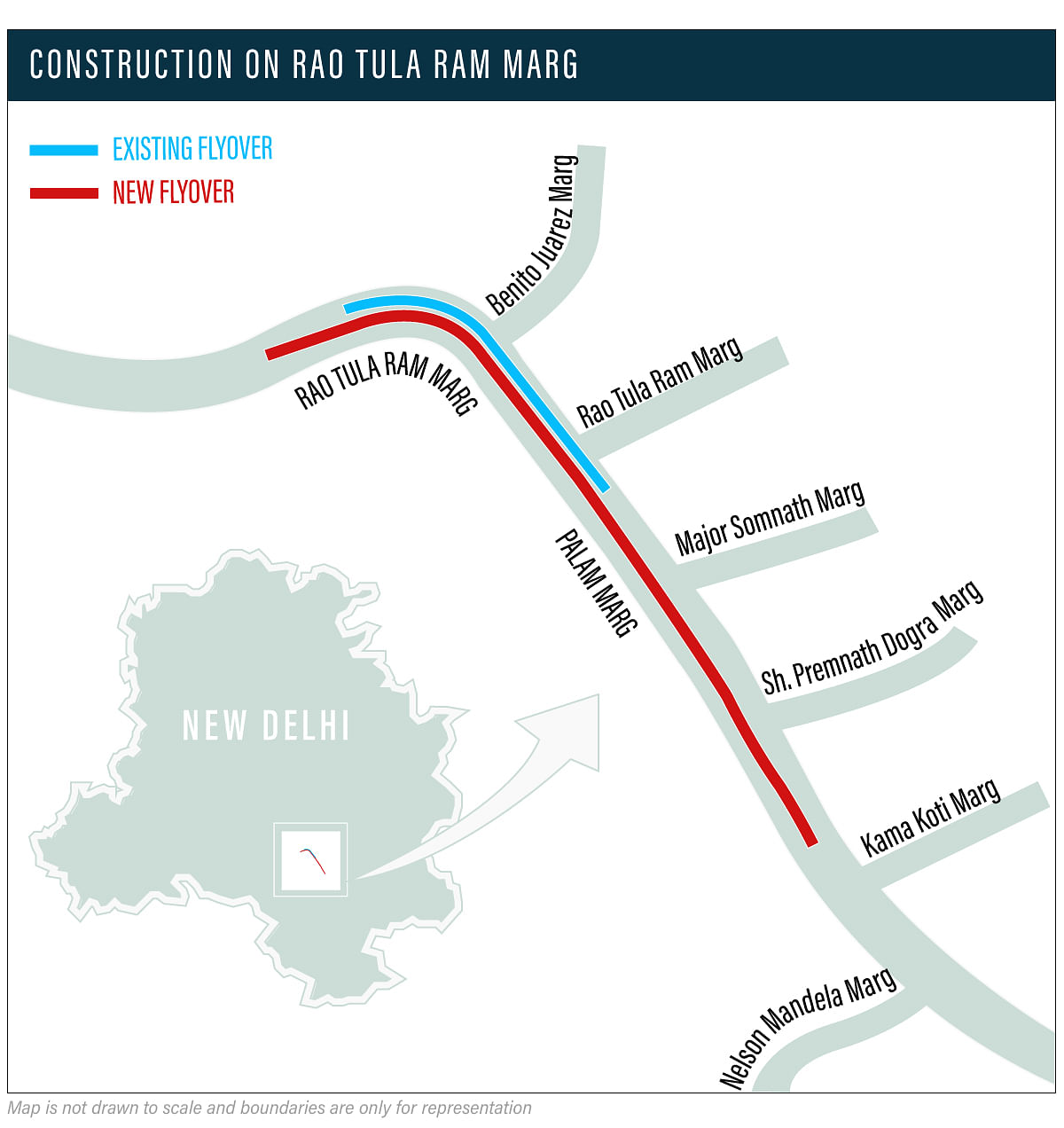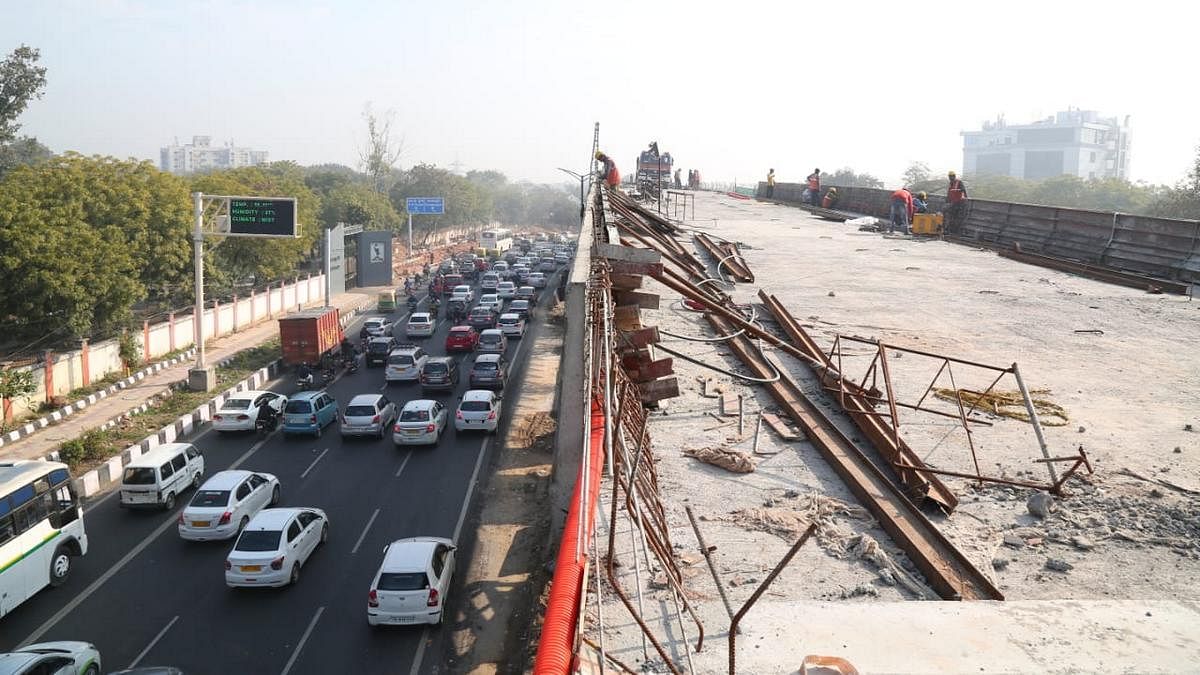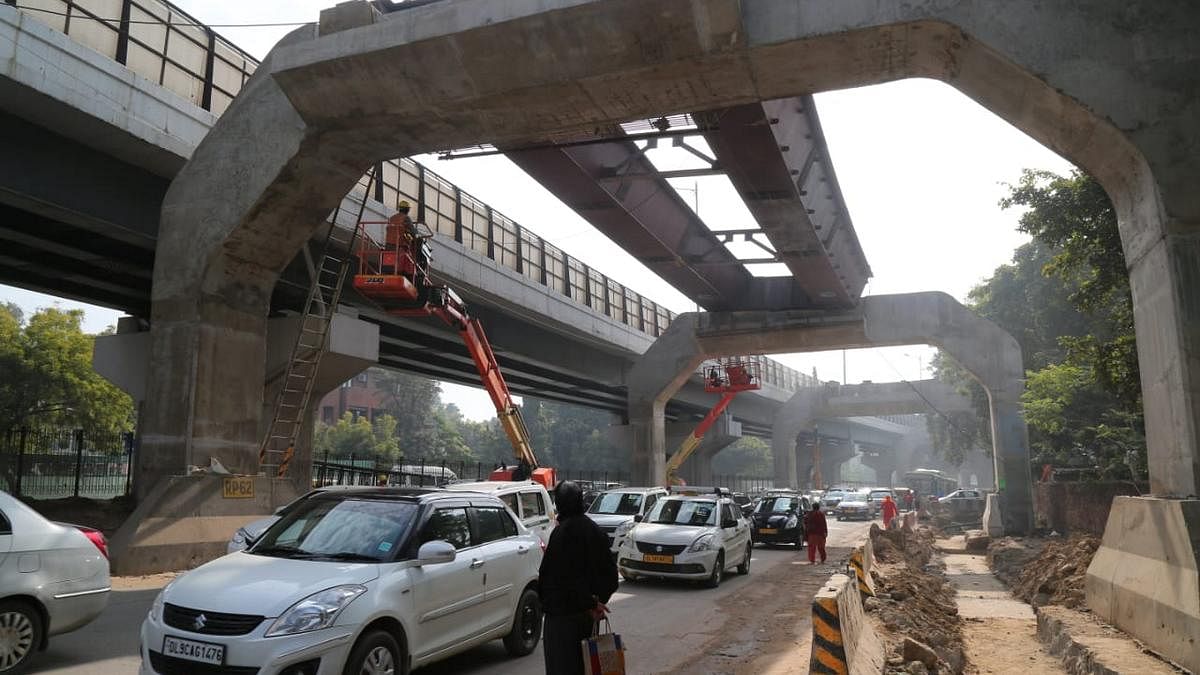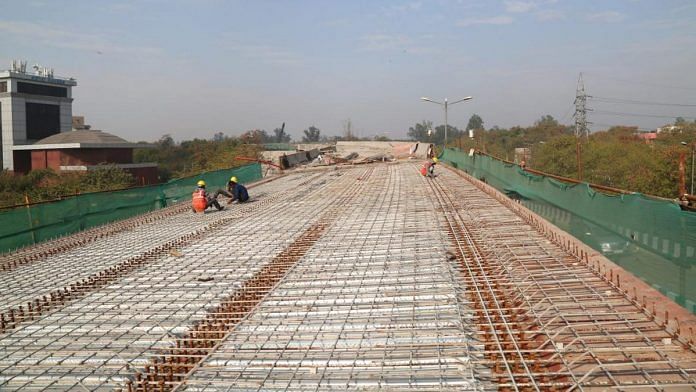New Delhi: This is a salutary story of how not to build a flyover. And India’s policymakers need to go no more than 10 km from the heart of the Indian capital to learn this lesson first hand.
The 2.7-kilometre Rao Tula Ram Marg flyover project in south Delhi was launched in November 2014. It has missed five deadlines and is likely to miss a sixth next month, with 30 per cent of the work still incomplete.
The delay is blamed on a lack of environmental clearances, poor infrastructural support along the construction stretch and a financial crunch faced by the contractor. Construction costs have spiralled to Rs 340 crore from Rs 278 crore in 2014 — a jump of 22 per cent.
The flyover project, which seeks to ease travel between south Delhi and the Indira Gandhi International (IGI) Airport — a key artery of the national capital — was conceived as one of the Public Works Department’s (PWD) most ambitious infrastructure projects in 2014. But today, it is being showcased as one of India’s slowest.
The new three-lane flyover is coming up parallel to a 900m-long single-carriageway flyover on Rao Tula Ram Marg’s T-junction with the Outer Ring Road near Vasant Vihar. The existing flyover was opened in 2009, but was ill-equipped to handle the estimated daily flow of about 2 lakh vehicles.
The parallel flyover begins near the foot of the existing flyover at Nelson Mandela Marg/Munirka petrol pump, and ends near the Army Hospital Research and Referral at Subroto Park.

Initial study and proposals
The story of the flyover begins like most other big projects in the national capital.
The inception report of the project was submitted by PWD in March 2012 and a comprehensive database was prepared for the study through extensive field surveys and secondary data. Traffic surveys were carried out from February to August 2012 with due consideration given to several school/college holidays, festivals and long weekends, which may have an effect on the traffic movement.
RITES, the public sector engineering company specialising in transport infrastructure, submitted the scenario report in May 2013, which was followed by submission of the proposals to the Unified Traffic Transportation Infrastructure (Planning and Engineering) Centre (UTTIPEC) to further coordinate with other agencies.
Manish Kumar Verma, director of UTTIPEC, said the flyover was envisioned to decongest the Outer Ring Road and ease airport- and Gurugram-bound traffic. “UTTIPEC approved the proposal after PWD surveys and a lot of analysis and research done on the stretch. The flyover will benefit the flow of traffic, as the proposal was formed after analysing the future traffic growth of the city,” he told ThePrint.
“Also, one cannot consider the RTR flyover in isolation. There is an underpass coming up at Benito Juarez Marg and a skywalk, which will ease the traffic not only in south Delhi but in central Delhi as well.”

Also read: India’s national highways have ‘black spots’ and they are dangerous
Troubled HCC awarded contract
In 2014, the Hindustan Construction Company (HCC) qualified as the lowest bidder for the construction of the three-lane flyover. HCC has handled projects like the Bandra-Worli Sea Link in Mumbai and the Badarpur elevated road in Delhi.
The 100-year-old company has constructed 25 per cent of India’s hydropower projects and 65 per cent of the country’s nuclear power generation capabilities. It has constructed close to 320 km of tunnels and over 365 bridges. The mega two-tier Bogibeel bridge over the Brahmaputra in Assam was one of the recent projects executed by the HCC, in joint venture with a Japanese company.
However, HCC is now debt-ridden and was barred from bidding for projects worth Rs 25,000 crore by government agencies in seven states in 2015.
The Mumbai-headquartered firm refused to comment or discuss the project for this report.
Why deadlines were missed
First deadline: November 2016
The first completion date set for the flyover was November 2016, but by that time, only 5 per cent of the work was completed by HCC, according to PWD officials. The project faced hurdles ranging from getting permission from the forest department to cut approximately 465 trees, and a lack of utilities such as power, water and sewerage lines.
A group of influential residents had also refused to sacrifice the service lane for the flyover to be built, and even moved court claiming that their private service lane was being encroached upon and that vehicles on the flyover would pass level with their top floors, affecting their privacy. The residents opposed the construction of the flyover from the time it was proposed.
Ruchir Vats, a resident of Vasant Vihar, said: “Our major concern was that of privacy. Another major problem was that of the noise barriers, which are apparently of no use. PWD had planned to install some effective noise barriers on this flyover but to no effect till date.”
Renu Singh, another resident, said: “Our parking area is occupied and there is not much space left on the road in front of our houses.”
Due to the delays, HCC was given 10 more months to complete the work. However, HCC officials claimed that adequate land was not given for construction work.
Second deadline: September 2017
Ten months later, only 30 per cent of the project was completed, even though the PWD claimed to have given 100 per cent of the land to HCC by June 2017. The permission to fell trees had been obtained by then, but HCC submitted in writing in February 2017 that the company was undergoing a financial crunch and the project would thus be delayed.
The contractor sought a further extension, following which another deadline was set. Mayank Saxena, executive engineer with the PWD, said: “We gave HCC a mobilisation advance at that time and it was approximately 10 per cent of the tendered amount, so that they could complete the remaining work. We went out of our way to help them.”
By September, utilities including power, water and sewerage lines were not still available, while Vasant Vihar residents continued to oppose the construction and later moved the Delhi High Court, filing a plea opposing the PWD’s decision to build the flyover. They also sought directions to the Centre and Delhi governments to find out why the existing flyover was designed as a single carriageway and take appropriate action against those responsible.
PWD officials say another hindrance around this time was that the Indraprastha Gas Limited was laying gas pipelines on the same stretch, due to which progress was delayed.
Third deadline: June 2018
Nine months later, the project was only 40 per cent complete. According to the PWD, the only hindrance left by this time was the HCC’s financial crisis as the Delhi High Court had dismissed the residents’ petition.
“The trees were all cut, power, sewerage and electricity problems were all eliminated. HCC sought another extension, but this time, the PWD gave only one more month to complete the remaining 60 per cent of the project, on a condition that a fine (10 per cent of the tendered amount) will be imposed if the project was not completed by 3 July 2018,” said a PWD official.
Fourth deadline: 3 July 2018
Until 3 July 2018, the construction of half the flyover (the airport end) had not even started. The PWD finally imposed a penalty of Rs 4.2 crore per month, to a maximum of 10 per cent of the tendered cost, which would amount to Rs 27.8 crore.
PWD’s Saxena said: “We had bank guarantees of approximately Rs 18-20 crore with us, out of which the penalty is deducted. Till the work is completed, HCC will continue to pay the fine.”
The new deadline set by the PWD was the end of December 2018.
Fifth deadline: December 2018
According to PWD officials, although the project saw better progress after the imposition of the fine, the work was still not completed, and yet again, HCC gave financial reasons for it. By this time, 55-60 per cent of the work had been completed, so the PWD decided to give HCC another deadline of 31 March 2019.
According to Saxena, after the imposition of the fine, “work amounting to approximately Rs 10 crore is being done every month, although at a slow pace”.
Sixth deadline: 31 March 2019
According to PWD officials, as on 11 February 2019, 70 per cent of the work has been completed. The officials are still hopeful that the 31 March deadline will be met, as they say there are “no more hurdles”.

Ballooning cost
According to PWD officials, the sanctioned amount for the project was Rs 313.67 crore, out of which Rs 278 crore was for the construction of the flyover alone. A senior PWD official said that the original cost of construction did not see any major rise but the utility cost witnessed an increase.
PWD had got Rs 14 crore as the utility shifting cost (tree-cutting, shifting sewerage lines, electricity lines etc) — Rs 7 crore for the flyover and Rs 7 crore for the underpass. But the utility cost for the flyover increased to Rs 15.9 crore, while the utility cost for the underpass increased to Rs 46.7 crore.
The cost of cutting trees alone was worth Rs 2.39 crore, exclusive of a security amount paid to the forest department.




It is not surprising at all. We
Are used to learn such news frequently. We are quite sure the we can’t bring any change.Rathe we are helpless lot.
Whose money drained ? Why not recover from the concerned ? Reply Modi ji. न खाऊंगा न खाने दूंगा . WAH MODI JI WAH WAH
AAP govt which prides itself on completing porjects in time and within the budget should take this challenge and complete the flyover asap.